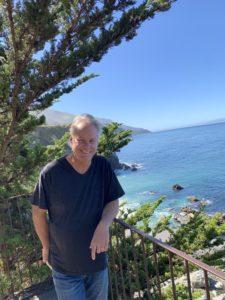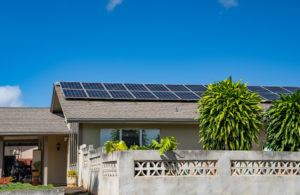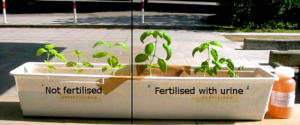June 30, 2022 – Volume 24, Issue 6
In This Issue
- Flanigan’s Eco-Logic: Visiting Esalen at Big Sur
-
Hawaii’s Last Coal-Fired Power Plant
-
Hawaiian Batteries and New-Age Net Metering
-
EV Equity
-
Peecycling
-
Germany Slashes Train Fares
-
European Solar Rooftops Initiative
-
World’s Largest Wind Turbine
- The NetPositive Podcast Updates

Flanigan’s Eco-Logic: Visiting Esalen at Big Sur
The Esalen Institute is a magical place. Amidst the grandeur of Big Sur, where massive coastal hills – the Santa Lucia Mountains – sharply meet the sea, there is the omnipresent sound of waves pounding the rocky shore. Esalen commands a special spot. It sits below the Pacific Coast Highway – the PCH – but high and safely above the ocean on a small flat and private plain.

Dropping into its 27 acres is like entering another world. There’s a calm. Esalen is a retreat center and “intentional community.” It focuses on humanistic alternative education. The Institute played a large role in the human potential movement in the 1960s. Everyone is honored here. A young and enthusiastic guard takes our temperature.
It had been years since I turned off the PCH and headed down the steep drive to the site. How many? Try 34? Sardo and I were there as Rocky Mountain Institute staff checking out lighting efficiency for Esalen. Now Terry and I are here on a retreat. Clean air and clear minds. Guided communications. Lots of inspired sharing.
Esalen serves healthy food, much of it grown on site. There are large gardens and the cafeteria serves a’plenty of organic food. Water is scarce in these parts, but Esalen enjoys a year-round creek complete with a redwood grove. The sun is shining and we swim at the pool. Then through the garden, redwoods, and by the meditation hut. We’re in a tented pavilion overlooking the sea… flaps up to lap up the sea breeze. A boat passes by… too close I fear. There’re rocks out there in that churn.
Forty-five miles south of Monterey, the grounds of Esalen were first home to a Native American tribe known as the “Esselen.” In 1882, the site was homesteaded by Thomas Slate. Its natural hot springs became known as Slates Hot Springs and brought in visitors seeking relief from aches and pains. In 1910, the land was bought by a physician from Salinas named Henry Murphy. We learned that it took the Murphys over two days to ride on horseback from Salinas to Big Sur. Murphy’s grandson, Michael, would later finally convince his grandmother to let him use the land to develop and run his center. Apparently, she found his interests quite odd.
The Esalen Institute was founded in 1962 by two Stanford graduates, grandson Michael Murphy and Dick Price, the latter at one point committed to a mental institution by his parents. The two had a vision. They sought to bring lots of creative people to the center, Esalen offering workshops and seminars and gatherings on a wide range of topics from philosophies, religious disciplines, and psychological techniques.
Such a colorful past the two founders created. An artist’s paradise. Aldous Huxley and Hunter S Thompson frequented Esalen, the latter with a shotgun to clear the baths. Two Beetles came by helicopter; Joan Baez was a resident. Crosby Stills and Nash performed at the pool; Stephen Stills’ mink coat drew ire. And the list goes on. Ravi Shankar gave George Harrison sitar lessons on the lawn overlooking the ocean. And it lives on. A bonfire at night with chants and songs.

Glorious days we had… blue skies, blusterous clouds. We look up to the dangerously steep mountainsides at Big Sur, panning down and down the ragged coastline. Overlooking the sea. The geography is stunning, a rich wind blows steady… perfect elements to stimulate the mind/body connection. The campus sits on a promontory; a refreshing breeze cleanses one’s spirit. It’s a reflective space. Then add hot mineral springs, baths along the cliffs of Big Sur. We soak and watch over the morning ocean waves, kelp floating on the surface.
Through 2016, Esalen site at Big Sur was hosting ~500 workshops with ~15,000 people attending and visiting each year. Key words: personal growth, meditation, hot springs massage, yoga, ecology, permaculture, organic food. Then devastating mudslides in 2017 wiped out the PCH on both sides of Esalen. Operations came to a grinding halt.
Guests had to be evacuated with helicopters. The mudslides and long-term road closure blocked access to Esalen. The organization nearly failed, but managed to rebuild with upgraded facilities and programming. Then the pandemic’s financial blow hit Esalen. But Esalen lives on. It’s nice to see the Esalen thriving again. We join and appreciate those dedicated to Esalen, those that work to manage and sustain its special niche in so many hearts. Esalen is a jewel hugging the California coast.
Quote of the Week
“While Oahu waits for the large solar projects to emerge from their thickets of permitting and grid studies, new residential solar and batteries can be up and running in just a day or two.”
Hawaii’s Last Coal-Fired Power Plant

The State of Hawaii has the goal to be 100% green in terms of power generation by 2045. And in some ways, it’s well on its way. It was the first state to make such a proclamation. It has the most solar installations per capita of any state by a factor of two. But it is also still the most petroleum-dependent state. It started importing coal in the 1980s to replace oil. Now it is working to completely shut down coal. And that’s only a few months away!
In September of this year, 2022, Hawaii’s last coal-fired power station – the Kapolei station on Oahu – is slated for closure. Enter the Kapolei Energy Storage (KES) just down the street from the AES plant. The 185 MW/565 MWh battery energy storage facility being built by Tesla is one of the world’s largest. For some years, Tesla has been working with Hawaiian Electric deploying virtual power plants. Now, 158 Tesla Megapacks are on their way to Oahu for their operation to coincide with the coal plant’s September closure.
Looking further into the future, Hawaiian Electric has a new Request for Proposals on the street, the third phase in its renewable energy solicitations. The new RFP is intended to identify new capacity to ramp down use of imported oil and to replace fossil fuel generation on Oahu and Maui. Eligible forms of capacities include but are not limited to, wind, solar, biomass, and biofuels.
For Oahu, HECO is seeking up to 500 MW by 2029 and 200 MW more by 2033. For Maui, HECO seeks at least 40 MW of firm capacity by 2027. So far, HECO has issued two RFPs thus far, one in 2018 and the second in 2019. They have resulted in 600 MW of solar and 3 GWh storage to be in service by 2024.

Hawaiian Batteries and New-Age Net Metering

In Hawaii, after years of serious acrimony, utility professionals and rooftop solar installers have agreed on a means to reward households for sharing clean energy with the grid at useful times.
Since 2015, net energy metering has been dead in Hawaii… and the rooftop solar industry took a serious hit. Consumers only sized systems large enough to self consume and to fill their batteries if they had them. Without net energy metering, much less solar was being ordered and installed.
Now, instead of utilities being forced to buy solar when they don’t need it – through a mechanism known as the “export credit” – utilities are finding means to pay for what they need and when they need. Specifically, give me your battery capacity from 6 – 8 pm. Stepping up is Hawaii Electric or HECO. It’s the big utility in Hawaii and it has been struggling to ramp up enough clean energy fast enough. Large-scale solar and battery projects’ schedules have slipped.
In 2021, HECO launched a consumer-owned battery program with high expectations, offering $850/kW for a ten-year commitment to discharge at peak times. The program called for 50 MW and got ~4 MW of participation. So, in 2022, Hawaiian Electric strengthened the program. In early June, the Hawaii Public Utilities Commission (HPUC) approved a peak capacity payment of $5 per kW and an export credit for power flowing from the batteries to the grid… at the retail rate. The HPUC ruled that, yes, households should earn money for keeping the grid flowing. This reflects a new form of net metering… providing valuable payments at times when the grid really needs it.
Digging into the details, there are really two versions of the Battery Bonus program. The first is for solar homeowners whose systems were installed prior to the 2015 termination of net energy metering. Their NEM is grandfathered. Add batteries and they get good values. The second group are those that installed solar after 2015 and have never had NEM. For them HECO is paying the monthly capacity payment and an export credit at the retail rate for those two hours a day. This is one form of new-age NEM, a decentralized power plant made up of thousands of homes… “1,100 peak, grid-edge solutions.”
In Hawaii, rooftop solar has gone from public enemy to public servant, reports Canary Media. Hawaii’s Public Utilities Commission used to limit generation to onsite use. Any more was considered a nuisance. Further, net energy metering’s value was cut. Now the Battery Bonus program pays handsome rewards to households for overproducing and sharing excess with the grid. Policy even lets old net metering customers add 5 kilowatts of new solar on their roofs, a net positive solar and climate solution.
EV Equity

The World Economic Forum reports that cost is the biggest barrier to EV ownership. So a number of interesting models emerge: A U.K. company allows for subscriptions for EVs complete with free charging at BP, Shell, and Tesla charging stations. The UK E-Car Club provides EV rentals by the hour. Or one can rent an EV from Onto on a monthly basis, and return the car after three months with no penalty if it’s not for you.
The Chinese firm, Nio, rents out batteries instead of selling them with the vehicle. This lowers the EV car price by 20%. In this configuration, drivers pull up to a station and swap out the battery pack, instead of charging their battery on board. (see EcoNet…Volume 24, Issue #1, Battery Swap Stations).
Utilities are getting into the business of promoting EVs with rebates. Peninsula Clean Energy, for example, offers rebates for used plug-in hybrids and used EVs, with base rebates of $700 and $1,000. Income-qualified customers get up to $5,700 and $6,000 for plug-ins and EVs. PCE is focused on equity… providing income-qualified customers means to access the benefits of EVs, notably lower fuel and maintenance costs.
Peninsula is also promoting EVs by offering rental EVs for free! If you live in San Mateo County or the City of Los Banos – the PCE service territory – you can get a $200 rebate “to experience the fun and ease of an EV.” The rebate amount covers the cost of a 2 – 3 day EV rental. Customers can rent from any company, and PCE recommends companies with large inventories of EVs such as Turo.
Peecycling

This may be one of the grossest articles I’ve ever written! It’s inspired by The New York Times, a June 17th article. A shortage of agricultural fertilizers, worsened by the war in Ukraine, has growers desperate. And here is a solution.
It just so happens that human urine has the very nutrients that crops need. So here we go… collecting urine! A story from Brattleboro, Vermont… where a flier posted in town invited locals to a community meeting to learn more. A woman who saw the posting had to work and couldn’t go, so she sent her husband. He came back with a jug and funnel!

Turns out that urine is full of the nutrients that plants need, more so than feces, and with almost no pathogens. What are the nutrients? Nitrogen, Phosphorus, and Potassium. NPK. The Big Three. Urine supplies NPK without the big environmental footprint of mining and manufacturing fertilizers.
Back to Brattleboro and local nonprofit Rich Earth Institute. The couple featured in the article, went from feeling “a little sloshy” about peecycling, to dropping off a couple of containers each week, to installing large tanks at their house that get professionally pumped out. The woman noted that she now “feels a pang of regret when she uses a regular toilet.” That’s a waste of precious resources.
Peecycling is certainly not unique to Vermont. A urine collection and application program in Southern Niger instigated by local women resulted in 30% increases in crop yields of pearl millet, the local staple. Since it was taboo there to use the word urine, the women renamed it “oga” which also means “boss” in the Igbo language. Apparently, to pasteurize the pee, it must stay in the jugs for two months, then it is diluted before applying to crops. Now entrepreneurial young farmers are getting into the oga business and its value has risen from $1 to $25 for 25 liters.
Back stateside, one of the issues with urine collection is its transportation costs. It’s mostly water which is heavy. If urine comes from urban areas, it needs to be transported to rural areas. Rich Earth Institute and University of Michigan are working to make sanitized pee concentrate, perhaps binding the urine on biochar made from feces. In Cape Town, South Africa, researchers are looking for ways to strip off the nutrients from the urine… to concentrate for ease in shipment.
In Paris, there is word of pee-diverting toilets being installed in 600 new apartments… the plan to treat the urine and use it for the City’s tree nurseries and green spaces..
Germany Slashes Train Fares

How to get people out of their cars? Try cheap train fares. The German Parliament decided to cut summer fares by as much as 90% to get summer travelers on trains and out of their cars. The Yale Environment reports summer fares set at 9 euros per month. (1 euro is worth $1.04) It’s called the 9 for 90 scheme… nine euros for 90 days. Initially the idea was to limit pollution, to cut greenhouse gas emissions. Now it’s a means to phase out dependence on Russian oil, and fast.
The initiative began on June 1 with 9 euros covering the cost of all buses, trams, subways, and regional trains, effectively cutting the fares by more than 90% in cities. Berlin commuters will save 98 euros on their monthly passes. Those in Hamburg will save 105 euros a month. Deutsche Bahn is adding 50 trains to absorb the expected increase in ridership. Critics call the government action too expensive, with an estimated price tag of 2.5 billion euros. The government will reimburse transit agencies for the lost fares.
Two other European countries have taken steps with transit fare to boost ridership and cut petroleum use: Italy and Ireland announced plans to cut fares on public transit in different ways. Ireland cut fares by 20% for the rest of the year; the first reduction in 75 years. Intercity service has also cut fares, and for young adults 19 – 23 years old, fares have been cut by 50% on all subsidized public transport. Italy’s “one-off” strategy is for students and workers earning less than 35,000 euros per year. They will get 60 euros in the form of an e-voucher that can be used when purchasing a ticket for these services.

European Solar Rooftops Initiative

On May 18, the European Commission presented the REPowerEU Plan, its response to the hardships and global energy market disruption caused by Russia’s invasion of Ukraine. It cited the urgency in ending the European Union’s dependence on Russian fossil fuels. The report presented the strategies: Energy Savings, Diversification of Energy Supplies, and Accelerated Roll-Out of Renewable Energy.
The plan calls for the deployment of heat pumps to eliminate heating oils. It calls for integrating geothermal and solar thermal energy in district energy systems. It also targets domestic green hydrogen production. The EU Solar Strategy is now to double capacity by 2025 and to install 600 GW by 2030. The solar rooftop initiative proposed calls for all new buildings to install solar.
The report finds that while solar photovoltaic (PV) prices have dropped by 80% over the last decade, solar only provided 5% of EU electricity in 2020. Solar’s share of heat production is even lower, at 1.5%. The EU plan includes forming the EU Solar Industry Alliance to support investments in manufacturing. China supplied 75% of the EU solar panel imports in 2020. The EU has had a hard time keeping up with China despite imposing anti-dumping and anti-subsidy controls on solar panels from China between 2013 and 2018.
The EU, with the support and direction of its members, will launch the European Solar Rooftops Initiative to help cut gas use for heating homes. It would push countries to use EU funding and launch support programs for rooftop panels, to install solar energy in all suitable public buildings by 2025, and to make sure that solar permitting of major facilities takes no more than three months.
World’s Largest Wind Turbine
Spanish-German wind giant Siemens Gamesa has been awarded a firm order for 60 of its new and massive, 14.7 MW wind turbines. The SG 14-222 turbines will be installed at the Moray West offshore wind farm in Scotland. The units will be the world’s most powerful wind turbines. Three per wind turbine, the 180 blades are 354-feet long. The turbines will have a rotor diameter of 728 feet. They will be produced in Hull, England, and installed in 2024. The turbine was tested in Osterild, Denmark test center. Electrek reports that the “world’s most powerful” title may not hold for long. Vestas is developing a 15 MW turbine that is slated to be installed at the He Dreiht offshore wind farm in Germany in 2025.
The NetPositive Podcast Updates

Recently Released:
This issue features stories on Esalen, Hawaii’s Last Coal Plant, Hawaii’s Battery Plus Program, EU Actions to Cut Russian Oil, Germany Slashing Transit Fares, Big Renewable Developments, and Peecycling.
Dave Munk has been Chairman of the Board of Holy Cross Energy for the past five years. Dave explains how a small, rural electric cooperative has adjusted to and embraced new technologies and consumer demands. With pride, he illustrates how Holy Cross Energy has taken a leadership position in what Dave calls “customer-centric utilities.”
Salem Afeworki is an inspiration. Born and raised on the Horn of Africa, in Ethiopia and then Eritrea, her early work with the UN Peacekeepers set her sights and launched her passions. She’s achieved educational feats to create her new life far from Africa. She’s recently worked for the City of Costa Mesa forming sustainability initiatives and firing up the community there.
Rob Pratt says he likes building things… and by that he means organizations.. He’s spent his career promoting energy efficiency and renewables… forming teams to get the job done. He’s promoted cogeneration systems in China, developed high head hydro in Central America, founded the International Institute for Energy Conservation and GreenerU. The podcast reflects a 40+ year career well done!
Check out and subscribe to The NetPositive with Ted Flanigan on Spotify, Apple, and Google. Episodes include Convos, Crash Courses, and EcoNet News.
